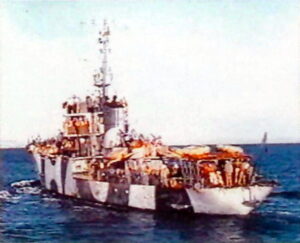 The Gabbiano-class corvettes were 59 vessels built for the Regia Marina in various yards during the Second World War, from a simple war-time design made for mass-production and dedicated to anti-submarine and escort. Of these, 49 were completed and many by and for the Germans. So they became also among the most common German light ships in the Mediterraneran until May 1945. The bulk of these corvettes entered service between late 1942 and late 1943 and thus saw little service. Many however saw further service, this time to hunt down Soviet subs of the Black sea fleet until 1972.
The Gabbiano-class corvettes were 59 vessels built for the Regia Marina in various yards during the Second World War, from a simple war-time design made for mass-production and dedicated to anti-submarine and escort. Of these, 49 were completed and many by and for the Germans. So they became also among the most common German light ships in the Mediterraneran until May 1945. The bulk of these corvettes entered service between late 1942 and late 1943 and thus saw little service. Many however saw further service, this time to hunt down Soviet subs of the Black sea fleet until 1972.
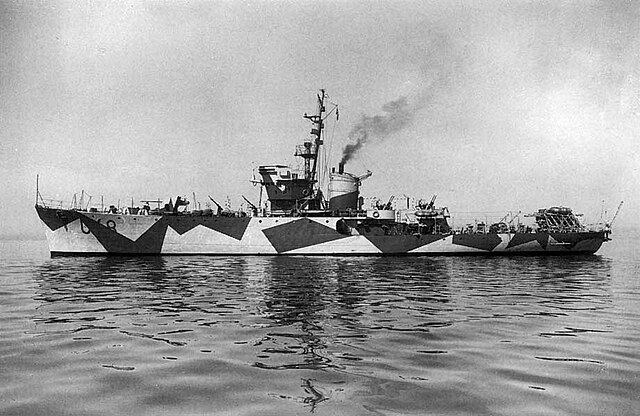
Development
Axis and Italian ASW in WW2
The axis powers in WW2 general were not well prepared to face ASW threats as much as themseves developed submarines and their associated doctrine. This impreparation to ASW did not penalized much the Kriegsmarine which ghuarded the Baltic well, and were not hampered much by Soviet submarine activity there, at least until 1945. The IJN was the most crippled by a lack of interest for ASW, as shown by the spectacular results of US Submarines in the Pacific, instrumental to win the war there. The Japanese started to work on series of ASW escorts late in this campaign, the bulk of which appearing in 1944-45.
On the Italian side, this was different. A simple check on the British submarine losses in the Mediterranean tells that the Regia Marina had taken perhaps ASW the most seriously of all axis members. This was traduced in several ways.

A French 1925 600 tonnes sub Ariane
First off, the rivalry with France from 1923 placed the Marine Nationale’s submarines as a threat to Italian line of communications, notably to Libya and east Africa. In 1928 all surviving WWI destroyers (most classes built from 1913) were re-rated as torpedo boats and due to the new destroyers standards of the 1930s, were better equipped for ASW and anti-mine warfare, systematically with depth charge racks, paravanes and WWI type basic hydrophones. In WW2 their complement of depth charges was often augmented.
After the fall of France in June 1940 it seemed the French submarine threat was no longer a reality, yet still, the RM was unprepared, having notably no good sonar not enough ASW dedicated vessels.
It even lacked the required training.
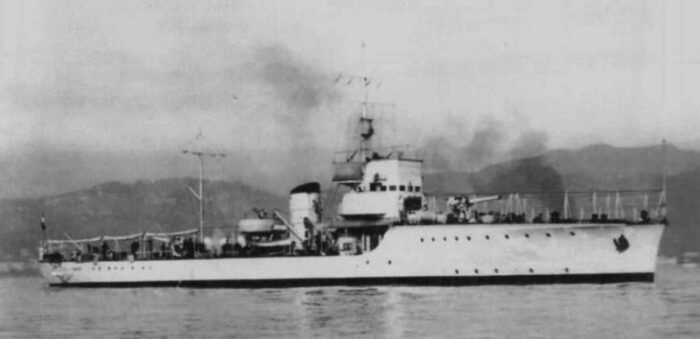
A first step was the experimental submarine chaser Albatros (1934) which tested various types of hydrophones and the first Italian sonar, the SAFAR 600, in 1939. The hydrophones were considered useless unless proceeding at very low speed, 4 knots but sonar the earned more promising results, and was was improved by SAFAR engineers but in 1940 it was stil not available.
Seeing this weakness in ASW Comando Supermo ordered the construction of four Orsa class torpedo boats as a development of the Spica with better range and depth charge launchers. But was not nearly enough.
Meanwhile after the fall of France, the RN started to produce submarines en masse, notably for compensating the relative inferiority on paper of the Britsh Mediterranean fleet facing the Regia Marina. The small S and U classes in particular were well adapted for the Mediterranean, and deployed there in immense majority. They took their toll on Italian convoys, and proved critical indirectly in the defeat of the axis in North Africa.
Thus the RM needed an answer, which was three-prone.
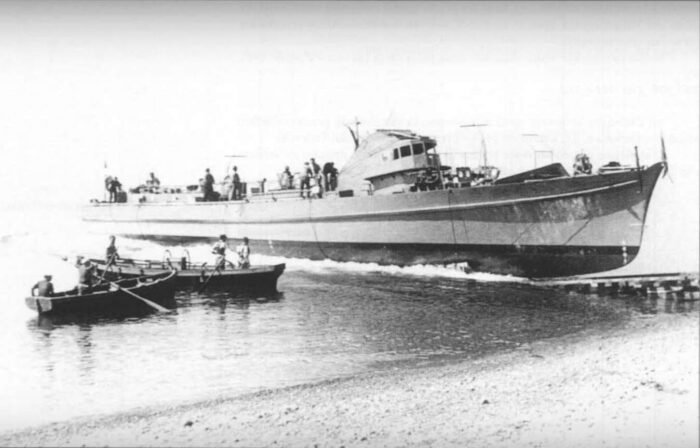
VAS Boat being launched
A large part of MAS boats (Motoscafo antisommergibili) were indeed conceived as ASW vessels, with their torpedo attack role almost secondary, it was in their very designation and name. They all carried indeed all 6 depth charges in small racks or drop collars and were often tasked or coastal ASW patrols.
As the ASW threat grew, the Regia Marina developed a small coastal dedicated vessel acronym VAS (Vedetta anti sommergibile) which was even more specialized. Larger at 68-90t and slower at 20 knots they had a far better range and 26 to 30 depth charges. This was the second answer, only available from 1942.
The third answer was the missing link between the ex-WWI torpedo boats and the new WW2 Italian Torpedo Boats by the way also for some (Orsa and Ciclone class) carried depth charges and had hydrophones, and the small boats described above. The Gabbiano class were largely based on the Albatros, but with a modified hull for better sea-keeping.
Development of the Gabbiano class
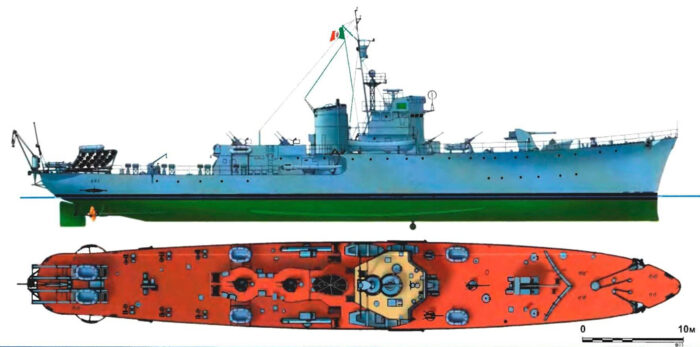
The need however for a semi-coastal and truly dedicated ASW ship emerged in 1941, perhaps partly inspired by the Flower class, rugged vessels tailored for the north Atlantic that could be mass-built by untaxed civilian yards on a modified civilian design. The Italian approach was different. The vessels were designed from the ground up as AW corvettes (Corveta anti sommergibile) and could have been named “CAS” with numbers as an enlarged version of the VAS boats, but instead they were also escorts with a enough range to accompany convoys on the longest possible routes between points in the Eastern Mediterranean. The VAS 1,100 nautical miles (2,000 km) were not going to cut it. VAS boats were built in 1942 alongside the new corvettes by the way. They did not preceded them.
Instead from the start these new corvettes were to be capable of 3,000 nmi (5,600 km; 3,500 mi) at convoy speed, so 15 knots at best. They were still to be capable of 18 knots runs if needed to rapidly exit a convoy for a chase and answer a call. One feature that was judged important, was the adoption of electric creep motors, in order to perform silent approaches at 6 knots over 16 nm in order to fool the targeted subs own hydrophones and to be able to listen themselves more carefully without interference. On that chapter, torpedo boats and destroyers made poor ASW hunters.
On the weapons side, there was just a single 100 mm/47 caliber gun and two 450 mm torpedo tubes for self-defence, against surface attacks or to destroy surfaced submersibles, a relatively good AA defence, and no less than eight to ten depth charge throwers plus racks for a total of 76 depth charges, as well as two Ginocchio towed ASW torpedoes (see later) and of course a good hydrophone, and when available later, the German S-Gerät sonar.
Construction
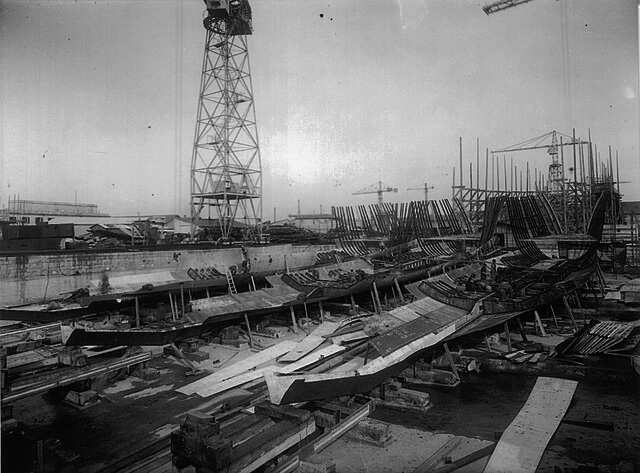
Capriolo, Alce and Renna in construction
In short, they were better adapted than Torpedo Boats and had better range than the VAS and MAS boats. The hull was simplified for mass production and much cheaper than torpedo boats as well, ensuring they could be built in a great variety of yards. In addition to the “usual suspects” Ansaldo in Genoa, CRDA (Cantieri Riuniti dell’Adriatico) in Monfalcone and Trieste, OTO in Livorno, they were built also in still untaxed yards such as Navalmeccanica in Castellamare di Stabia, Breda in Porto Marghera, and Cerusa in Voltri (3 ships). Construction time was short, many, including a bunch laid down in January 1942, such as Gabbiano herself and others. The class namesake was indeed launched six month later on 23 June 1942 under the first pennant (C11) at Cerusa yard, completed four months later by December 1942. The 1942 naval plan was ambitious, together with twelve “Capitani Romani” class light cruisers and two dozens of Medagie D’Oro class destroyers (non completed) as well as extra torpedo boats and VAS boats, and “metals” class submarines.
No less than sixty Gabbiano class vessels were ordered in January 1942, but only half (29) were completed, and not all under Regia Marina service: Ape, Baionetta, Berenice, Camoscio, Chimera, Cormorano, Danaide, Driade, Euterpe, Fenice, Flora, Folaga, Gabbiano, Gazella, Gru, Minerva, Persefone, Sfinge, Sibilla, Urania, Vespa. For some, only for a few days before capture by the Germans with the armistice.
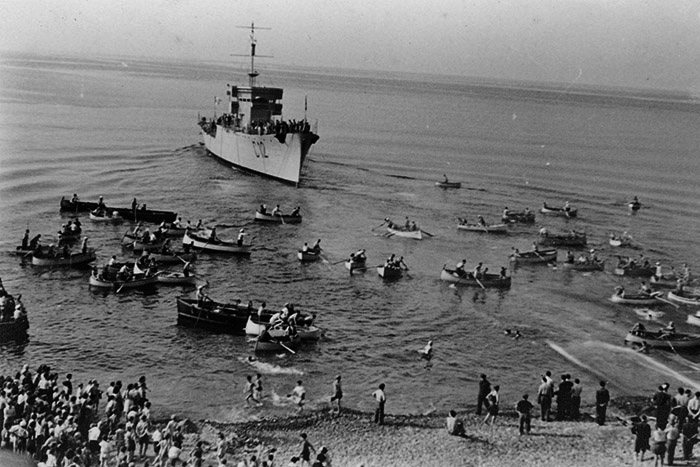
Procellaria after launch
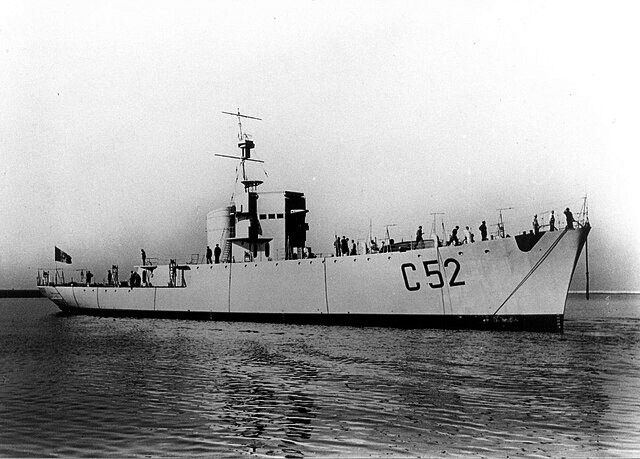
Marangona just after launch
The Kriegsmarine indeed captured only a few, and many more still incomplete, most completed for their own service about 20 ships, named UJ- (UnderseebooteJäger). The Gabbiano class all had “C” pennants (for Corvetta) and animals or marine deities names. The optical identification letters differed from that adopted by destroyers, torpedo boats as it consisted of numbers starting from 11 up to 70, preceded by the letter “C” painted in red to stand our, and this method was considered more suitable and easier to adopt for such a large number of units instead of name letters.
The units were ordered in 2 series, the first including ships from C 11 to C 50 and the second from C 51 to C 70. On each site, different families of names were adopted:
ANSALDO shipyards had them named after sea birds: Seagull, Ardea, Stork, Cormorant, Coot, Crane, Ibis, Cormorant, Pelican, Petrel, Black-throated Diver, Little Grebe.
NAVALMECCANICA shipyard named them after insects: Bee, Hornet, Grasshopper, Cicada, Cochineal, Chrysalis, Butterfly, Cricket, Dragonfly, Firefly, Beetle, Wasp.
O.T.O. shipyard named them after of mountain quadrupeds: Antelope, Elk, Chamois, Roe Deer, Deer, Fallow Deer, Gazelle, Reindeer, Ibex.
C.R.D.A. shipyards named them after Roman deities: Artemis, Berenice, Chimera, Danaid, Dryad, Egeria, Eurydice, Euterpe, Phoenix, Flora, Melpomene, Minerva, Persephone, Pomona, Sphinx, Sibyl, Terpsichore, Urania.
BREDA shipyard named them after ancient weapons: Scimitar, Bayonet, Bombard, Carbine, Club, Colubrina, Axe, Spingarda, Zagaglia.
Of the 60 units ordered, only 29 were delivered to the Royal Navy before September 8, 1943. 3 were lost in action before the Armistice, 4 were captured by the Germans, 1 sunk by the Germans and 2 scuttled themselves to avoid capture. 19 survivors served under well after war and subjected to numerous modernizations for the Marina Militare. 2 others were completed after 1945 (Crisalide and Farfalla) and one refloated (Bombarda) in Venice and all three comprehensively modernized. They were still part of NATO ASW arsenal in the 1960s.
Of the corvettes that did not enter service with the Regia Marina, almost all were captured by German forces in the days following the armistice. Some were scuttled or destroyed shortly after, notably while fitting out or being built in Castellammare di Stabia and others were completed under German supervision and entered service with the Kriegsmarine. Six of these were however never completed. Of the units entering Kriegsmarine, some were sunk in action or in port under allied raids, and scuttled at the end of the war.
Design of the class
They were designed with the hull lines of the “Ostia” class minelayers which proved to be successful as a base. Their hull was built in non-calmed Thomas type steel, less valuable than the Martin-Siemens normally used for the military units. So a civilian steel grade which was more affordable. Completion was facilitated by the relative lack of installations, as they were launched with already the small bridge installed and rear structure up. In all, superstructures represented only 1/4 of the hull’s global size, with perhaps 1/8 of its mass.
Hull and general design

They had a a clipper bow ending with a still a traight and bulbous chin, very fine entry lines. They had a rounded bow with a vee lower section, some sheer, and a clear gap after the stern chutes to avoid ant depth charge back move. The depht charges racks themselves were quite prominent (see below). The hull was only straight around the bridge, at deck level, and up to the stern. There was a sheer and flare for the bow for seaworthiness, which was good, a relatively low draught as well. For a displacement of 660 tonnes standard and 728 fully loaded, they measured 58.8 meters between parallel (192 ft 11 inches) and 64.4 meters overall (211 ft 28 inches) with a breadth of 8.71 meters (28 ft 7 in) and 2.53 in draught (8 ft 4 in).
The hull had a high forecastle and tall bridge superstructure amidship, single funnel aft of it. This helped to provide good seaworthiness, which lacked in smaller Italian escort vessels such as the VAS and WWI destroyers reused as escorts. The concentration of weight at a narrow point amidships made them stable platforms, with limited roll and pitch. The hull was fitted in any case with counter-keels.
The compact bridge structure comprised a map room at the first level, an enclose main navigation bridge on the upper level with narrow windows, and an open bridge above for easier subs detection. The tall bridge also ensured to see subs easier but it mostly depended on the spotting top installed on the main tripod mast aft. The lower part of this mast was attached to a lattice mast supporting the main searchlight platform. The crew of 110 counted on three small boats, one barge starboard, a small cutter and a yawl on port, on deck. There were six life rafts placed at strategi points, brightly colored as well.
Powerplant

C45 Pomona and C33 Scimitarra at full speed
The propulsion, was one of the first exlamples of combined powerplants for surface vessels, with diesels for normal running, and two electric motors for silent running in order to allow them to carry out searches in the almost total absence of vibrations and noise sources, making it easier to approach enemy subs without being detected. The Fiat M 407 diesels were built in 1942 by FIAT Grandi Motori. Those installed in Monfalcone and Trieste were built by the Fabbrica Macchine “Sant’Andrea” of Trieste and some units were equipped with Fiat M 407 from Ansaldo (ships built by Ansaldo except Gabbiano, Procellaria, Folaga, Ibis, Ardea and ships built by Navalmeccanica except Ape, Vespa, Lucciola, Grillo).
The output was 3500 bhp for the diesels and 300 shp for the electric creep motors.
Bombarda and Carabina’s diesels were rated for 3,500 bhp. Top speed was a modest but difficient in their role 18 knots, and still 6 knots using the creep engine. Let’s recall there that most submarines of the time were barely able of 7 knots at best underwater, 5 knots being the norm.
For autonomy, they were provided by 64 tonnes of diesel oil in two loer hull internal tanks. This was enough for 3,000 nautical miles () at 15 knots. On creping morots they could do 16 nautical miles at 6 knots.
Armament
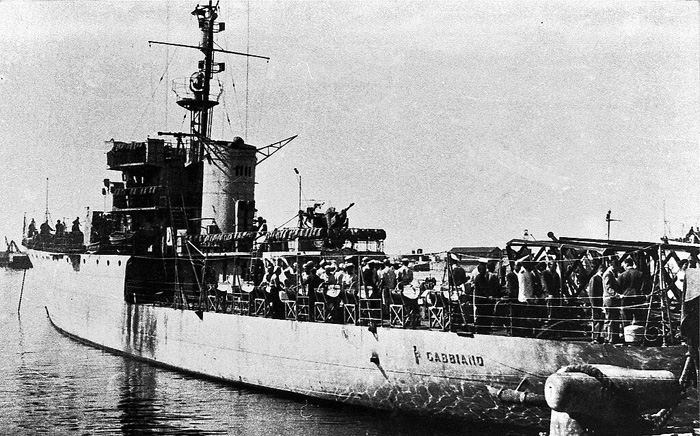
Stern view of Gabbiano as completed
As a baseline they were completed with a pretty rounded armament to face all threats: A single purpose 100mm/47 OTO 1937, twp twin 20mm/65 Breda 1935 at the rear of the funnel in a raised bandstand, three single 20mm/70 Scotti-Isotta Fraschini 1939, but also two single 450mm TT not installed in all vessels, rounded by eight depht charge throwers on the aft deck and two Depht charge racks at the stern with chutes, for a grand total of 76 depht charges. They also had two Ginocchio towed ASW torpedoes, detailed below.
Urania differed by having three single 20mm/65 Breda 1940 insted of Scotti-Isotta Fraschini models, whereas Bombarda, Crisalide and Farfalla had two 40mm/60 Bofors Mk 1, and two 20mm/70 Oerlikon, stll their torpedo tubes but four DCT instead of eight and no tracks.
100 mm/47 OTO mod.1937 Dual-purpose single mount
This gun derived from an Austrian model of WW1, the Škoda 10 cm K10 & K11 made used the modello 1910. The modello 1924 was the first made as an AA twin mount (Cavour class BBs, Trento class, Zara class, Condottierri class and others). The DP single appeard as the Modello 1931 first with a -6°/+45° angle, used by TBs. Both modello 31 OTO 1935/37 saw little use unlike the OTO modello 1937, used on the Ariete, Ciclone, Spica, Orsa class TBs, and Gabbiano-class corvettes. It had a partial shield protecting the gun forward. Specs below.
See on navweaps
⚙ specifications 100mm/47 (3.9 in) OTO 1937 |
|
| Weight | 2,02 tonnes barrel alone (4,450 lb) |
| Barrel length | 4.700 meters (15.4 ft) 47 caliber |
| Elevation/Traverse | +60°, 300° hand-worked |
| Loading system | Horizontal sliding breech block |
| Muzzle velocity | 880 meters per second (2,900 ft/s) |
| Range | c16 km (10 mi) at 60°, ceiling 8 km /60° |
| Guidance | Optical |
| Crew | 8 |
| Round | 13.75 kilograms (30.3 lb) Fixed QF 100 x 892R |
| Rate of Fire | 8-10rpm |
45 cm (17.7″) Si 200/450 x 5.36
This model was developed and used by MAS boats. The 450 x 5.25 was a bit more compact. They were both developed at Naples (Silurificio Italiano) Torpedo factory. On the Gabbiano class they were located on two individual tubes just aft of the forecastle break on the weather deck. Since there was no shortage of room the Gabbiano clas likely used the longer variant (specs below).
⚙ specifications Si 200/45 |
|
| Weight | 2,050 lbs. (930 kg) |
| Dimensions | 17 ft. 7 in. (5.750 m) x 450 mm (18 inches) |
| Propulsion | Wet-heater |
| Range/speed setting | 2,200 yards (2,000 m) / 44 knots |
| Warhead | 441 lbs. (200 kg) |
AA Guns: Breda 20/65 Mod. 1935
Ubiquitous piece of ordnance present on virtually all Regia Marina ships. The Gabbiano were well armed wit their two aft twin mount and extra single mounts. Generally they were located close to the bridge pointing forward on both sides, and close to the aft structure. The twin Breda mounts were in tandem as 20mm/65 Breda 1935. The single ones were 20mm/70 Scotti-Isotta Fraschini 1939 models. It was called the Cannone-Mitragliera da 20/77 (Scotti) and only required a crew of two with “flying loaders” bringing out new clips. This was a good AA defense but did not prevented a few losses due to air raids. The Scotti is closer in design to the Oerlikon, with a +85° levation, 250 rpm cyclic, 830 m/s (2,700 ft/s) Muzzle velocity and 2.1 km (6,900 ft) range max.
Some ships were rearmed with allied 40 mm Bofors and 20 mm Oerlikon/70 in the co-belligerence.
⚙ specifications Breda 20 mm AA |
|
| Weight | 330 kg twin, 72 kg single barrel mount |
| Dimensions | 1,87 m oa, 1.3 m barrel |
| Traverse/elevation | 360°, -10° a +80° (Mod. 39) |
| Powder charge | 38 g |
| Round | 20 × 138 mm B 0,34 kg, gas-operation, 12 rds clips |
| rate of fire | 240 rpm cyclic max, 150-120 rpm practical |
| Muzzle Velocity | 840 m/s |
| Crew | 2-4 |
ASW suite
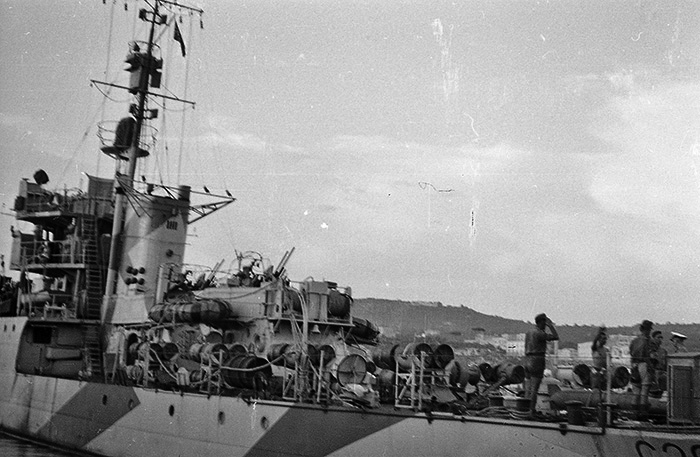
UJ 2221 ex Vespa at Pozzuoli, showg her ASW aft deck apparatus and throwers
Depth Charge Throwers
Up to ten throwers, but more generally eight placed along the aft hull on either side. They comprised the gun proper and two reloads each for rapid service. The charges were attached to their dispensable cradle spoon.
B TG Monc. 50/1936: 141 lbs. (64 kg), 110 lbs. (50 kg) charge. Unknown sink Rate or Terminal Velocity or Settings.
Designed and fired by the 30 cm (11.8 in) DC Throwers.
The B TG Scot. 100 was a larger model weighting 282 lbs. (128 kg) with a 220 lbs. (100 kg) intended for 43 cm (16.9 in) DC Throwers. It is not clear if the latter were installed at some point on the Gabbiano class corvettes.
Depth Charge Racks
There were two very unique “Gatteschi” type multi-level racks used on the Gabbiano class. Unique in that they could hold five to six trolleys each containing two to four DC. When the first was empty (8 combined), a second could be relased and so on in rapid succession if needed. When emptying the whole two racks, this made of a 40+ charges pattern overall, quite a massive hammering. This system was unique at the time and proper to the Regia Marina, making them among the world’s best ASW vessels before the introduction of the Hedgehog. Knowing that each Gabbiano had 74 depth charges total (24 for the DCTs) but this could go up to 86. It is dubious if they had reloads.
There were also large stocks of older models available, like the following:
B TG Monc. 50/1917: 110 lbs. (50 kg), single setting
B TG Monc. 50/1927 4 Reg.: 110 lbs. (50 kg), 20, 40, 70 and 100 m (65, 130, 230 and 330 feet) settings
B TG Monc. 100/1927 4 Reg.: 220 lbs. (100 kg), 25, 50, 75 and 100 m (80, 165, 250 and 330 feet) settings
Ginocchio Towed Torpedo
Quite different in use and philosophy compared to paravanes, they were a concept of World War I consisting in a towed torpedo streamed over the stern near a submarine contact in hope it would strike the submarine and triggering its warhead. Depth-keeping was a problem in sea trials and its operational use was limited overall. They were both located at the poop, with a crane for recovery, launched head first in vertical cradles. The French also had a go on it but the project was formally suspended in 1933 after trials in the Chacal and Bourrasque-class destroyers. The Ginocchio came in two with the same 30-kilogram (66 lb) TNT warhead with inertial fuze:
“medium” capable of 15 to 37 m (49 to 121 ft) depth, 62 kilograms (137 lb), 1.62 meters (5 ft 4 in) long.
“depth” model for 53 meters (174 ft), 75.5 kilograms (166 lb), 1.72 meters (5 ft 8 in) long.
Sensors
They all had an Italian hydrophone as a base, however when the S-Gerät sonar was available, the Regia Marina asked the Kriegsmarine to provide it and by the end of 1941, Orsa, Castore, Sagittario and Lince all had this model, but operated by German personnel. Italian personnel was sent to Germany to train on these at the Kriegsmarine school in Gotenhafen. By June 1942, 12 destroyers, 18 torpedo boats and 16 auxiliaries had the S-Gerät.
From early 1943, the new Corvettes of the Gabbiano class and many had the S-Gerät, with tensions on deliveries due to German use. It is possible some were installed by the Germans on their own completed Gabbiano class units, which were not many. The S-Gerät was an early type only capable of detecting a submarine with precision under 400-500 meters so quite short ranged, however it could detect any object 4 km away. It transmitted sound pulses and timed the returning echo to detect underwater objects. Because it emitted sound pulses which also broadcasted the carrier, so this device was not very popular. They were usually fitted and mass produced for U-Boats. At least the Italian hydrophones were passive listening devices only with a handwheel to turn the receptor at any angle around the ship.
As for the bespoke SAFAR 600, it was only tested on Albatros but never equipped the Gabbiano class.
Bombarda, Crisalide, Farfalla postwar were equipped with SO-13 radar and QCU-2 sonar.
Profiles

C19 (Antilope) showing more ash gray in proportion to the rest. Most ships had far less extensive dark grey areas (pinterest).
All completed corvettes entered service camouflaged, with standard colors of ash gray over a lead gray base, with hard angles geometric shapes designed to break their lines. The hull was painted underwtzer in the standard Green. It was a classic scheme in the Regia Marina widely spread in 1941-43, woith the usual red-white bands painted over the foredeck for air recoignition. The only corvette to adopt an opaque white was the Artemide, which entered service on 10 October 1942, even though this paint had already been discarded since the summer on other ships. Camouflage schemes were different from unit to unit.
Another 2-views depiction in 3D, from pinterest.
Under German service it could differ, albeit on UJ 2221 (ex Vespa) the original Italian camouflage scheme was maintained but in time, more camouflage schemes were applied in various tone of grey. Also the Germans added a balkankreuz (german straight cross) on the hull’s sides forward and erase previous ID markings. In general, they were handsome ships at most angles and deserves all the love of modellers today. Here are a few example of patterns below (wikimedia CC).
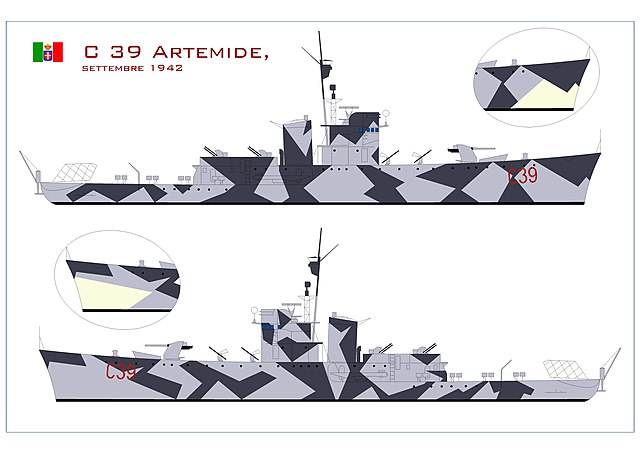
Artmemide

Fenice
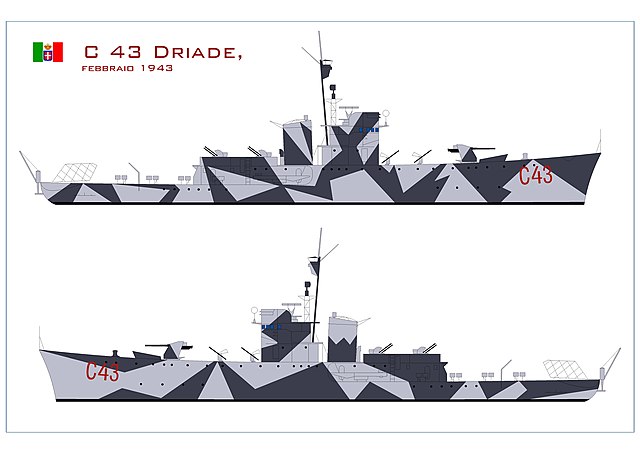
Driade
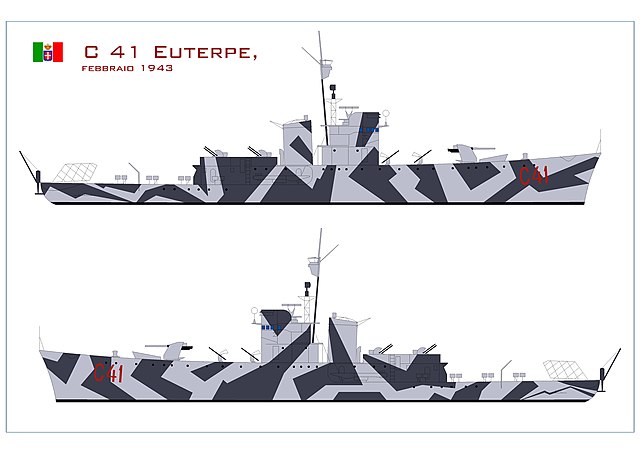
Euterpe: All, Italian Naval Camouflage of WWII – Marco Ghiglino, CC
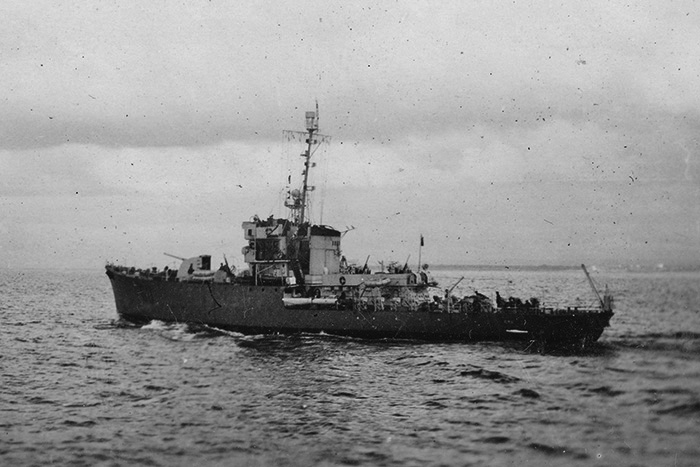
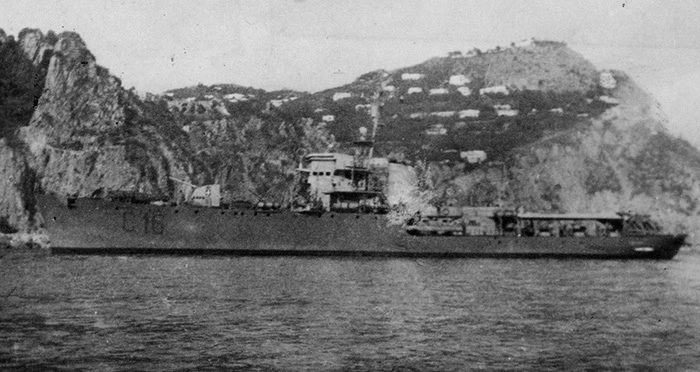
Note that during the co-belligerence, these ships afopted the allied standard lower dark grey hull, lighter grey upper structures, like Gru and Folaga above in 1944-45.
More to come (author’s profile)
⚙ specifications |
|
| Displacement | 660 long tons (671 t) standard, 728 long tons (740 t) full load |
| Dimensions | 58.8 x 8.71 x 2.53m (192 ft 11 in x 28 ft 7 in x 8 ft 4 in) |
| Propulsion | 2 shaft Diesel 3,500 bhp (2,600 kW) |
| Speed | 18 knots (33 km/h; 21 mph) |
| Range | 3,000 nmi (5,600 km; 3,500 mi) at 15 knots (28 km/h; 17 mph) |
| Armament | 1× 100 mm/47, 7× Breda Modello 35 20mm, 2× 450 mm TTs 10× DCTs |
| Sensors | Sonar and hydrophones |
| Crew | 110 |
Use in the cold war
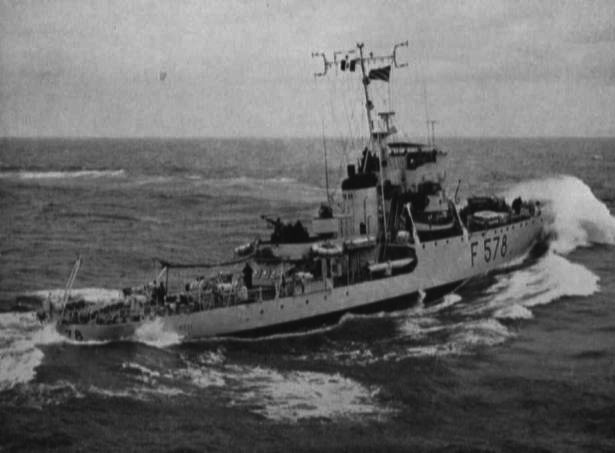
Baionetta in the cold war, pennant F-578, reclassified as ASW frigate.
In the post-war period, the surviving units, which had become part of the Navy, were subjected to major modification works, particularly in the armament, and the electric motors were removed. Having abandoned the camouflage painting, the surviving units until around 1951 used the co-belligerence painting, which included dark grey colouring for the hull and light grey for the superstructures; in this period the optical identification badge was changed, returning to the traditional two-letter system, then switching to light grey colouring and, starting from February 1953, adopting the new NATO optical identification system, which included the letter “F” for all units classified as “2nd class escort ships” (frigates, torpedo boats and corvettes), followed by a three-digit number starting with “5” for Italian units.
The Ape in 1948
Of the units that remained in service, 16 took part in the complex operations of demining the seas at the end of the war, after having disembarked all the anti-submarine armament and embarked the mechanical dredging equipment. In 1947 the anti-submarine armament concentrated in the stern area was replaced with dredging equipment, and relatively modern electronic equipment was installed. During this first cycle of work, the units underwent a remodeling of the command bridge, the twin Breda 20/65 Mod. 1935 machine guns were replaced with a twin 40/56 complex, the shielding of the 100/47 gun was extended to improve personnel protection (a modification already studied in 1943 but implemented only in a few units before the armistice). As for electronics, Ape, Bombarda, Chimera, Crisalide, Driade, Farfalla, Gabbiano, Gru, Ibis, Minerva, Pellicano, Scimitarra and Urania were equipped with a SO 13 cassette radar, installed on the head of the mast with the exception of Ape and Chimera, where the radar was placed on the tripod; Cormorano, Danaide and Sfinge adopted the ASP/SN-6 Westinghouse air search radar, installed on the tripod, while Baionetta, Fenice, Flora, Folaga, Pomona and Sibilla were equipped with a SMA navigation radar type NSM 8, placed on the tripod, with the exception of Folaga and Pomona which embarked it on a shelf halfway up the mast.
Further modernization works were carried out later between 1952 and 1954 and during these works three other corvettes of the class were recovered and completed: Bombarda, Crisalide and Farfalla, to form a homogeneous group of 22 corvettes, which formed the backbone of the smaller vessels of the rebuilt Italian Navy. After this second cycle of works all the units removed the 100/47 gun, with the exception of the corvette Folaga which retained it for a long time, and were divided into two groups, anti-aircraft escort for convoys and anti-submarine escort for convoys.
The corvettes Gabbiano and Bombarda were armed for the anti-aircraft component with two 40/56mm guns and two Scotti-Isotta-Fraschini 20/70 machine guns and for the anti-submarine component with a porcupine four bomb launchers and two bomb dischargers.
The corvettes Ape, Chimera, Cormorano, Danaide, Fenice, Flora, Folaga, Pellicano, Pomona, Sibilla and Sfinge were armed for the anti-aircraft component with four 40/56 mm guns and for the anti-submarine component with a porcupine, four bomb launchers and two bomb dischargers.
The corvettes Baionetta, Crisalide, Driade, Farfalla, Gru, Ibis, Minerva, Scimitarra and Urania were armed for the anti-aircraft component with three 40/56 mm guns and for the anti-submarine component with a porcupine, four bomb launchers and two bomb dischargers.
The corvettes of the Gabbiano class were used for team training activities, for patrolling tasks, fishing surveillance and for training in command of the TT. VV at the school in Augusta. In their activity they were supported by the corvette Alabarda, a former British minesweeper, and by three corvettes of the Antilope class, three former minesweepers of German origin that were engaged in various tasks before being used as corvettes, and took the names of three units of the Gabbiano class: Antilope, Daino and Gazzella. Subsequently, the units of the Gabbiano class were supported by the units of the Alcione class, the first escort units built in Italy in the post-war period. Some of the units were decommissioned in the second half of the sixties, while the others left the scene in the seventies with the entry into service of the corvettes of the De Cristofaro class.
Ape underwent extensive transformation works, which lasted from 1963 to 1964, completely changing the appearance of the unit to be able to perform the task of support ship for the COMSUBIN raiders. During these works, a tuga at the bow and the forecastle was extended; the entire stern area was cleared of anti-submarine armament to be used for launching the special vehicles of the raiders and the unit was armed only with two single 20/70 machine guns placed on the sides of the deckhouse. Since the ship was no longer classified as an escort unit, but as an auxiliary ship, it was assigned the optical identification A 5328, previously adopted by the Montegrappa and Etna. The ship carried out these tasks from 1965 to 1979, the year in which it was decommissioned. Among the units of its class, the Ape corvette had the longest operational life. After being decommissioned in 1981, it was sunk in February 1986, during an exercise, by a “Teseo” missile launched from the frigate Euro. All Minerva class units bore the names of units that had been part of the Gabbiano class.
Career of the Gabbiano class
 Berenice (C 66)
Berenice (C 66)
Berenice (C 66) was laid down at CRDA, Monfalcone on 20 May 1943. She was sunk on 9 September 1943.
 Bombarda (C 38)
Bombarda (C 38)
Bombarda (C 38) was built at Breda, launched on 31 August 1942, sized working up, Completed as UJ-206.(to be completed in future upgrades)
 Calabrone (C 30)
Calabrone (C 30)
Calabrone (C 30) was launched at Navalmeccanica on 27 June 1943. She was under German control and not renamed.
 Camoscio C 21
Camoscio C 21
Camoscio C 21 was launched at OTO, Livorno on 9 May 1942, ended as German UJ-6081, Sunk by USS Somers on 15 August 1944 (Battle of Port Cros)
 Capriolo C 22
Capriolo C 22
Capriolo C 22 was launched at OTO, Livorno on 5 December 1942, Completed as UJ-6083.(to be completed in future upgrades)
 Carabina C 37
Carabina C 37
Carabina C 37 was launched at Breda on 31 August 1943 and completed as UJ-207.(to be completed in future upgrades)
 Cavalletta C 31
Cavalletta C 31
Cavalletta was launched at Navalmeccanica on 3 December 1942, captured by the Germans, never completed and BU postwar.
 Cervo C 56
Cervo C 56
Cervo was laid down OTO, Livorno and continued as UJ-6086, not completed.
 Chimera C 48
Chimera C 48
Chimera was started at CRDA, Trieste, launched 30 January 1943. (to be completed in future upgrades)
 Cicala C 29
Cicala C 29
Cicala was started at Navalmeccanica, launched 27 June 1943, captured by the German, not renamed nor completed.
 Clava C 63
Clava C 63
Clava was laid down at Breda, never completed annd captured by the German; broken up incomplete.
 Cicogna C 15
Cicogna C 15
Cicogna was laid down at Ansaldo, Genoa, launched on 12 October 1942 and sank the British Submarine HMS Thunderbolt (former HMS Thetis) with depth charges on 14 March 1943 off Sicily. Cicogna was sunk during an allied air raid on 24 July 1943, too damaged for repairs and scuttled.
 Cocciniglia C 61
Cocciniglia C 61
Cocciniglia was laid down at Navalmeccanica, never launched, never completed.
 Colubrina C 35
Colubrina C 35
Colubrina (C 35) was laod down at Breda, launched on 7 December 1942 captured by the Germans in Sept. 1943, Completed as UJ205.
 Cormorano C 13
Cormorano C 13
Cormorano was laid down at Cerusa, launched on 20 September 1942, completed. Sank or damaged three German small vessels on 9 September 1943 off Bastia, Corsica. Decommissioned 1966.
 Crisalide C 58
Crisalide C 58
Crisalide was laid down at Navalmeccanica; never launched, never completed, scrapped on slip.
 Alce (C 23)
Alce (C 23)
Alce (C 23) was launched at O.T.O. Livorno on 27 May 1942 but incomplete at the armistice, fitted out in Livorno. Captured by the Germans on 9 September 1943 she was renamed UJ 6084 and assigned to the VI Sicherungsflottille. On 8 January 1944 she left Livorno in tow of Vesuvio for completion at La Spezia and Genoa. In June she carried out sea trials and entered service in July. She was transferred to Toulon in early August to contest the Allied landing in Provence (Operation Dragoon) but on the night of 15 August 1944, together with UJ 6081 (ex Capriolo) while south-east of Toulon she found no allied unit but the next day hit a mine while leaving the port, ran aground on the shallows, abandoned when the city fell, refloated in 1946 and BU.
 Antilope (C 19)
Antilope (C 19)
Antilope (C 19) was from OTO, Livorno, lunched 9 May 1942. Third unit of the class after a brief training in La Spezia under Roberto Lucciardi, she joined the I Corvette Squadron based in Trapani, for convoy escorts in the Strait of Sicily. On 17 January 1943 with Artemide and Gabbiano, she rescued the crew of the destroyer Bombardiere, torpedoed and sunk by HMS United. On 30 March 1943, in a night-time ASW operation off Trapani and in low visibility, she was mistook for an enemey vessel and attacked, hit by shells from the torpedo boat Pegaso, suffering considerable damage. After repairs on 11 April, she left with one working engine for Livorno and complete repairs at the Caprera slipway. On 28 May she was badly damaged while on slip by an air raid, which was flooded. On 9 September 1943 she was captured by the Germans who were never able to repair her due to the damaged slipway. She ws BU postwar.
 Ape (C 25)
Ape (C 25)
Ape (C 25) was built at Navalmeccanica, launched 22 November 1942 and she entered into service in May 1943, under Lieutenant Rodolfo Balbo di Vinadio. She was assigned to the IV Corvette Squadron and from August, II Squadron in La Maddalena. At the armistice she was in Portoferraio. On 10 September she sailed out to join the allies at Malta and with Folaga and Cormorano, TB Aliseo, she took part in a naval action against German E-Boats. The corvettes were forced to run aground on Populonia beach. The following day with the tide and some effort, she left and reached Malta on 20 September. On 6 October, she returned to Taranto and started co-belligerence patrols. From October 1943 to 8 May 1945 she escorted Allied and Italian convoys and served in the cold war as well, until decommission on 31 July 1981 in an auxiliary role by the time. Quite a career.
 Ardea C 54
Ardea C 54
Ardea was laid down at Ansaldo, Genoa in 1942, not launched after capture as UJ-2225, never completed.
 Artimede C 39
Artimede C 39
Artimede was laid down and launched at CRDA, Monfalcone on 9 August 1942 captured before completion, became German UJ-2226.
 Danaide C 44
Danaide C 44
Danaide was laid down at CRDA, Trieste, launched on 21 October 1942, never completed.
 Daino C 55
Daino C 55
Daino was laid down at OTO, Livorno, never launched, captured, never completed as UJ-6087.
 Driade C 43
Driade C 43
Driade was laid down and launched at CRDA, Trieste on 7 October 1942, never completed.
 Egeria C 67
Egeria C 67
Egeria was launched at CRDA, Monfalcone, captured, became UJ-201, sunk by the Free-French destroyer Le Terrible in the Battle of Ist, 29 February 1944
 Euridice (C 70)
Euridice (C 70)
Euridice was launched at CRDA, Monfalcone, captired, became UJ-204, never completed.
 Euterpe C 41
Euterpe C 41
Euterpe was launched at CRDA, Monfalcone on 22 October 1942, in service with the RM, along with sister ship Minerva sank the British submarine P247 on 14 August 1943. Scuttled September 1943.
 Farfalla C 59
Farfalla C 59
Farfalla was laid down at Navalmeccanica; never completed.
 Fenice C 50
Fenice C 50
Fenice was laid down at CRDA, Trieste and launched on 1 March 1943, never completed.
 Flora C 46
Flora C 46
Flora was laid down at CRDA, Trieste, launched 1 December 1942, never completed.
 Folaga C 16
Folaga C 16
Folaga was lunched at Ansaldo, Genoa on 14 November 1942, never completed.
 Gabbiano C 11
Gabbiano C 11

Gabbiano was built at Cerusa, launched on 23 June 1942 (lead boat), with acceptance trials from 12 August 1942, first of her class in service. On 6 October she had fixes at La Spezia for a with training and was assigned to the I Corvette Squadron, Trapani, first convoy on 10 January 1943 with Antilope and Artemide, led by TB Sirio and Pallade, and escorting the tanker Saturno between Palermo and Bizerta. On 17 January 1943, she recued men from the destroyer Bombardiere sunk by HMS United. On 21 February she rescued 51 from German steamship Baalbeck,sunk by HMS Unruffled off Cape Bon. On 24 April 1943, she left Reggio Calabria for Tunis with Euterpe and Climene, Bassini, escorting the Galiola. 5 miles north-west of Cape Milazzo, Galiola was torpedoed by HMS Sahib and sank. The escorts started their hunt and sank her after prolongated depht charging when surfacing. Gabbiano rescued 6 from her crew, Climene the rest, 51 including commander and 5 officers. In total she carried out 102 missions, with 18 anti-submarine hunts, 22 convoys. With the armistice under Lieutenant Nilo Foresi she was under repairs with Pellicano in Gaeta awaiting orders. On 9 September, surrounded by German contingents she managed to sail to the island of Montecristo, then Bastia and on 13 September Palermo. From September 1943 to April 1945, she was in co-belligerence, escorting Allied convoys to Malta, Bizerte and Algiers. On 8 May 1945 she was in Naples. She was modernized postwar and in service until decommissioned on 1 November 1971.
 Gazzella C 20
Gazzella C 20
Gazzella was laid down and launched at OTO, Livorno on 9 May 1942 completed in February 1943, assigned to the I Corvette Squadron, La Spezia for training, under Lieutenant Arrigo Montini. On 19 April, she was damaged by an air raid and and joined the II Corvette Squadron, La Maddalena for coastal convoys. On 11 April 1943, she escorted the tug Salvatore I en route for the cruiser Gorizia to La Spezia but collided with the torpedo boat Dezza. On 5 August 1943, with Minerva north of Asinara, she hit a mine and sank (wreck rediscovered 2002) after 63 missions.
 Grillo C 28
Grillo C 28
Grillo was laid down at Navalmeccanica, launched on 21 March 1943, captured by the German, neither renamed or completed.
 Gru C 18
Gru C 18
Gru was laid down and launched at Ansaldo in Genoa on 23 December 1942, entering service in April 1943, training at La Spezia, assigned to the I Corvette Squadron in Naples for coastal convoys. In the last month before the armistice she completed a single convoy escort mission and six anti-submarine sweeps. She was in Gaeta under Lieutenant Fazio Casari and on 10 Sept. she sailed to the island of Ponza. On 21 September she was in Palermo and Augusta, reached Taranto and was in co-belligerence, escorting Allied convoys and transporting personnel and materials. She served in the cold war, modernized and was decommissioned on 1 August 1971.
 Ibis C 17
Ibis C 17
Ibis was laid down at Ansaldo, Genoa and launched on 12 December 1942. She entered service in April 1943, assigned to the I Corvette Squadron, Naples, escorting convoys in the Tyrrhenian Sea. From 3 April to 8 September 1943, she amde 35 missions, including 8 anti-submarine hunts, four attacks. On 28 June between La Spezia and Naples, she claimed a submarine, no British confirmation, believed damaged. On 6 September 1943 under Lieutenant Giulio Pelli, she left Gaeta with a Anglo-American liaison crew on board but off Ustica it was transferred to TB 046 and two high-ranking US officers boarded her, taken to Gaeta. On 7 September she was sent in secret to the bay of Porto Conte (Alghero) in “quarantine” until 16 September and left for Ajaccio to start transferring Italian soldiers to Sardinia, landing at Porto Torres. On the 21st she left for Ajaccio to bring food for troops still present in Corsica, fighting against the Germans. For her co-belligerence except from 29 September 1944 to 11 April 1945 when refitted in Taranto, she escorted Allied convoys. On 8 May 1945 she was in Naples. She served in the cold war and was decommissioned on 1 July 1971.
 Libellula C 32
Libellula C 32
Libellula C 32 Navalmeccanica German; broken up
 Lucciola C 27
Lucciola C 27
Lucciola C 27 was laid down at Navalmeccanica and launched on 21 March 1943. This corvette was supposed to be called Zanzara, later changed. When the armistice happened she was still fitting out in Castellammare di Stabia. On 13 September she was captured by the Germans, never completed, scuttled it in port before abandoning the city, 17 September. From 23 November 1951 she was refloated and BU.
 Marangone C 52
Marangone C 52
Marangone was laid down at Ansaldo on 16 September 1943 and Completed as UJ-2223. She entered service in the 22nd Unterseebootejäger Flottille on 18 March 1944 for coastal convoy escort and on 11 May, together with UJ 2222 (ex Tuftetto) she fought British motor torpedo boats and survived. On the night between 23 and 24 May 1944, she was torpedoed and sunk by PT 202, PT 213 and PT 218, her sister UJ 2222 was seriously damaged and back to Livorno, repairs were never completed.
 Maggiolino C 60
Maggiolino C 60
Maggiolino was laid down at Navalmeccanica in 1943, never launched not completed, BU on slip
 Melpomene C 68
Melpomene C 68
Melpomene C 68 was laid down at CRDA, Monfalcone, launched on 29 August 1943, Completed as UJ-202. On 24 April 1944 she started sservice with coastal convoys. On 25 June 1944 alongside TA 37 (ex Gladio), TA 38 (ex Spada) and TA 39 (ex Daga), she towed TA 22 (ex Missori), damaged by Allied raid in Trieste. On 12 August with TA 40 (ex Pugnale), TA 37, TA 38 and TA 39 and the minelayer Kiebitz (ex RAMB III) she was in a minelaying mission in central Adriatic, first of several such missions. Between 9 and 11 Octobe with UJ 208 (ex Spingarda) and 4 E-Boote of the III Schnellbootflottille she was in an anti-partisan mission against Melada Idland. She later towed back the damaged S 626 by partisan battery fire to Pola, 11 October. She sortied again with TA 40, G 234 and the tanker Prometheus to Trieste when by night, the convoy was attacked by MTBs, but escaped. On 1 November 1944 with UJ 208 in Quarnerolo Channel (Pago-Lussino) she was caught by British destroyers, HMS Wheatland and Avon Vale, and all were sunk, TA 20 (ex Audace) later.
 Minerva C 42
Minerva C 42
Minerva was laid down CRDA, Monfalcone and launched on 5 November 1942. Along with her sister ship Euterpe she sank the British submarine HMS Saracen on 14 August 1943. Decommissioned in 1970
 Pellicano C 14
Pellicano C 14
Pellicano C 14 was laid down at Cerusa, launched 12 February 1943. After entering service in May 1943, she joined the I Corvette Squadron in Naples and served for two months before the armistice, 39 missions total but only one escort, 11 search missions. On 8 September 1943 she was in Gaeta under Amleto Ferraù. She escaped capture by the Germans, to Montecristo, and Bastia. She reached Palermo on the 16th, Malta on the 19th and on 5 October 1943 Taranto for her co-belligerence until 8 May 1945, in Cagliari. Served in the cold war, decommissioned on 1 July 1969.
 Persefone C 40
Persefone C 40
Persefone was laid down at CRDA, Monfalcone, launched 21 September 1942, Scuttled September 1943.
 Pomona C 45
Pomona C 45
Pomona was laid down at CRDA, Trieste, launched on 18 November 1942. Commissioned on April 1943 she trained in Pola and was assigned to the III Corvette Squadron, Brindisi, escorting convoys between Brindisi-Bari or Brindisi-Taranto. On 8 September 1943, under Lieutenant Riccardo Gladi, she was in Brindisi and on the 16th left Bari with Ulisse, Borsini and Pallade to recover civilian and military personnel from Pelagosa and Lagosta. Next she was in Taranto started co-belligerence missions, and was in Naples on 8 May 1945. She served in the cold war until decommissioned on 1 June 1965.
 Procellaria C 12
Procellaria C 12
Procellaria was laid down at Cerusa, launched 4 September 1942. She entered service on 29 December 1942, trained at la Spezia, assigned to Ist Anti-submarine Corvette Squadron with missioned to and from Tunisia. On 31 January 1943, under Lieutenant Giorgio Volpe she left Bizerta for Trapani with her Persefone, MS 16 and 35, and German F 481 and 484, destroyer Maestrale (badly damaged), towed by the torpedo boat Animoso. 24 miles north-west of Cape Bon, she struck a mine astern and sank after 3 hours, 24 deaths went down with her after 18 missions.
 Renna C 24
Renna C 24
Renna was laid down at OTO, Livorno, launched 5 December 1942, Completed as UJ-6085 after being towed to Genoa. Entered the 6th Security Flotilla but on 16 August, then transferred to the 22nd Flotilla as UJ 2230. While fitting out, sunk in a massive Allied air raid on Genoa on 4 September 1944.
 Scure C 62
Scure C 62
Scure was laid down at Breda , renamed UJ-209, not completed.
 Scimitarra C 33
Scimitarra C 33
Scimitarra C 33 was laid down at Breda, launched 16 September 1942. She entered service in May 1943, trained in Pola, assigned to the IV Squadron, Brindisi. From 16 July to 8 September 1943 she performed 17 anti-submarine hunts and 5 convoy escorts. On 8 September 1943 under Lieutenant Remo Osti she was in Durazzo after escorting a convoy. She left for Brindisi and at Pescara picked up the Royal Family on Baionetta until then, and on 11 September arrived in Taranto. From October 1943 she was in colbelligenrence missioned and on 8 May 1945, in Palermo. She served in teh cold war and until 1 August 1971.
 Baionetta (C 34)
Baionetta (C 34)
Baionetta was built at Breda, launched on 5 October 1942, morning of October 5, 1942, and fitting-out went on until the summer 1943, entering service on July, 27 under Captain Piero Pedemonti. After training on September 9, 1943, she left the Adriatic for the south to Malta and the port of Pescara, embarking Marshal Badoglio, Head of Government and ministers as well as the Chiefs of Staff, in an historical trip. Later she went back to in Ortona to take back King Vittorio Emanuele III and the royal family and entourage which had left Rome at first light on September 9. Ortona was fell to the germans just a day later. Given the shortage of life jackets on board (57) Admiral and C-i-C Raffaele De Courten authoritatively suspended boardings amid vehement protests.
On September 10, Baionetta sailed to Brindisi, escorted by Scimitarra and the cruiser Scipione Africano, and at 4:00 p.m. they arrived safely, being overflown by German aircraft all along. In the following months, Baionetta took part in co-belligerence missions of convoy escorts for the allies in the Adriatic, Ionian and Tyrrhenian Seas and once torpedoed by a German U-boat but survived.
Postwar she was used to search for and locate sunken hulls, in order to diepose them off as hazards to navigation. She was used for routine transport and in 1948 was in the Middle East, stopping at Beirut, Jaffa, Haifa, and Cyprus. She was a training ship for a new echo sounder under the III Naval Division. Between 1952 and 1956 with the twenty-two surviving Gabbiano class corvettes she underwent a comprehensive modernization:
-Installation of a modern US sonar (see notes)
-Installation of a US radar for close-range detection NSM8
-Installation of a better US echo sounder
-Replacement of the 20mm/65 mm by a single twin 40mm/65 Breda-Bofors (aft deckhouse)
-Single-deck bomb dischargers (6 each) aft.
-Forward 100mm/47 replaced by a single 40mm/65 mm Breda-Bofors
In August 1962, Baionetta joined the Naval Logistics Group. From January 1966 she trained with the new Corvette Squadron (all modernized shios) and was decommissioned in November 1, 1972 and BU.
 Sfinge C 47
Sfinge C 47
Sfinge was laid down at CRDA, Trieste, launched on 9 January 1943. Delivered in May 1943, after a quick training in Pola, she reached Brindisi, III Corvette Squadron with convoys from Albaniaa and on 8 September 1943, under Lt.Cdr. Vincenzo Vaccarisi she was in Durazzo, left for Brindisi and Taranto. From October she escorted Allied convoys in the Ionian and Lower Tyrrhenian Sea when when transporting goods and personal in southern Italy. On 8 May 1945 she was in Naples, she served in the cold war, modernized, decommissioned on 15 June 1977.
 Sibilla C 49
Sibilla C 49
Sibilla was laid down at CRDA, Trieste, launched on 10 March 1943. (to be completed in future upgrades)
 Spingarda C 36
Spingarda C 36
Spingarda was laid down at Breda, launched 22 March 1943, Completed as UJ-208. (to be completed in future upgrades)
 Stambecco C 57
Stambecco C 57
Stambecco was laid down at OTO, Livorno not launched, not completed, renamed UJ-6088.(to be completed in future upgrades)
 Strolaga C 53
Strolaga C 53
Strolaga was laid down at Ansaldo, Genoa, never completed, renamed UJ-2224.(to be completed in future upgrades)
 Tuffetto C 51
Tuffetto C 51
Tuffetto was laid down at Ansaldo in Genoa on 25 August 1943 and Completed as UJ-2222.(to be completed in future upgrades)
 Tersicore C 69
Tersicore C 69
Tersicore was laid down at CRDA, Monfalcone, not launched, never completed but renamed UJ-203.(to be completed in future upgrades)
 Urania C 65
Urania C 65
Urania was laud down at CRDA, Monfalcone and launched on 21 April 1943.(to be completed in future upgrades)
 Vespa C 26
Vespa C 26
Vespa C 26 was laid down at Navalmeccanica and launched on 22 November 1942. Captured, she became German UJ-2221 after September 1943.(to be completed in future upgrades)
 Zagaglia C 64
Zagaglia C 64
Zagaglia was laid down at Breda Yard but never completed.(to be completed in future upgrades)
Read More/Src
Books
Conway’s all the worlds fighting ships 1922-1946 page 316-317
The Gabbiano Class Corvettes: Part 1″ by Elio Andò in “Warship Volume IX”
Naval Weapons of World War Two” by John Campbell
Italian Warships of World War II” by Aldo Fraccaroli
The Naval Institute Guide to World Naval Weapon Systems 1991/92″ by Norman Friedman
Links
navypedia.org/
history.navy.mil /italian-corvette-gabbiano.html
comandosupremo.com/gabbiano-class-corvettes/
marina.difesa.it/ gabbiano.aspx
navalwarfare.blogspot.com/
it.wikipedia.org/wiki/Classe_Gabbiano
en.wikipedia.org/ Gabbiano-class_corvette
commons.wikimedia.org/ Gabbiano_class_corvette
Videos
Model Kits
Main query on scalemates
The subject was covered in 1:350 and 1:700 by Niko Model and SSModel.
modelwarships.com/r driade.html
maquetland.com/ gabbiano-mkt-venise-musee-naval
hlj.com cicogna
comandosupremo.com/ antisubmarine capabilities regia marina ww2/
skytrex.com/ gabbiano class corvette


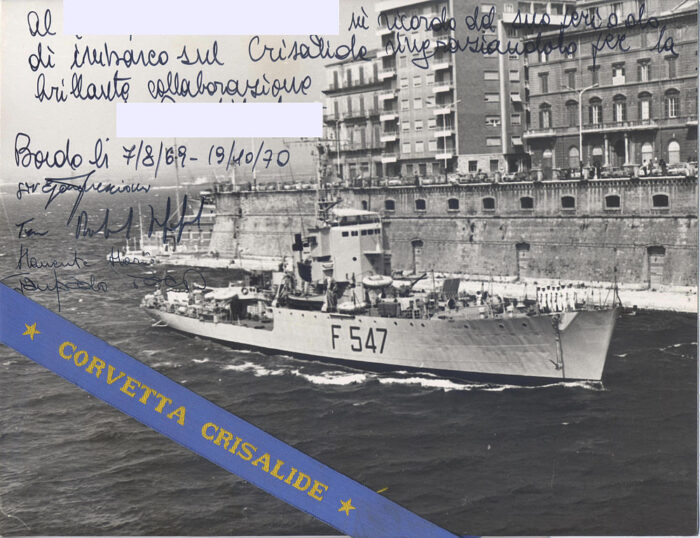
 Latest Facebook Entry -
Latest Facebook Entry -  X(Tweeter) Naval Encyclopedia's deck archive
X(Tweeter) Naval Encyclopedia's deck archive Instagram (@navalencyc)
Instagram (@navalencyc)





 French Navy
French Navy Royal Navy
Royal Navy Russian Navy
Russian Navy Armada Espanola
Armada Espanola Austrian Navy
Austrian Navy K.u.K. Kriegsmarine
K.u.K. Kriegsmarine Dansk Marine
Dansk Marine Nautiko Hellenon
Nautiko Hellenon Koninklije Marine 1870
Koninklije Marine 1870 Marinha do Brasil
Marinha do Brasil Osmanlı Donanması
Osmanlı Donanması Marina Do Peru
Marina Do Peru Marinha do Portugal
Marinha do Portugal Regia Marina 1870
Regia Marina 1870 Nihhon Kaigun 1870
Nihhon Kaigun 1870 Preußische Marine 1870
Preußische Marine 1870 Russkiy Flot 1870
Russkiy Flot 1870 Svenska marinen
Svenska marinen Søværnet
Søværnet Union Navy
Union Navy Confederate Navy
Confederate Navy Armada de Argentina
Armada de Argentina Imperial Chinese Navy
Imperial Chinese Navy Marinha do Portugal
Marinha do Portugal Mexico
Mexico Kaiserliche Marine
Kaiserliche Marine 1898 US Navy
1898 US Navy Sovietskiy Flot
Sovietskiy Flot Royal Canadian Navy
Royal Canadian Navy Royal Australian Navy
Royal Australian Navy RNZN Fleet
RNZN Fleet Chinese Navy 1937
Chinese Navy 1937 Kriegsmarine
Kriegsmarine Chilean Navy
Chilean Navy Danish Navy
Danish Navy Finnish Navy
Finnish Navy Hellenic Navy
Hellenic Navy Polish Navy
Polish Navy Romanian Navy
Romanian Navy Turkish Navy
Turkish Navy Royal Yugoslav Navy
Royal Yugoslav Navy Royal Thai Navy
Royal Thai Navy Minor Navies
Minor Navies Albania
Albania Austria
Austria Belgium
Belgium Columbia
Columbia Costa Rica
Costa Rica Cuba
Cuba Czechoslovakia
Czechoslovakia Dominican Republic
Dominican Republic Haiti
Haiti Hungary
Hungary Honduras
Honduras Estonia
Estonia Iceland
Iceland Eire
Eire Equador
Equador Iran
Iran Iraq
Iraq Latvia
Latvia Liberia
Liberia Lithuania
Lithuania Mandchukuo
Mandchukuo Morocco
Morocco Nicaragua
Nicaragua Persia
Persia San Salvador
San Salvador Sarawak
Sarawak Uruguay
Uruguay Venezuela
Venezuela Zanzibar
Zanzibar Warsaw Pact Navies
Warsaw Pact Navies Bulgaria
Bulgaria Hungary
Hungary

 Bundesmarine
Bundesmarine Dutch Navy
Dutch Navy Hellenic Navy
Hellenic Navy Marina Militare
Marina Militare Yugoslav Navy
Yugoslav Navy Chinese Navy
Chinese Navy Indian Navy
Indian Navy Indonesian Navy
Indonesian Navy JMSDF
JMSDF North Korean Navy
North Korean Navy Pakistani Navy
Pakistani Navy Philippines Navy
Philippines Navy ROKN
ROKN Rep. of Singapore Navy
Rep. of Singapore Navy Taiwanese Navy
Taiwanese Navy IDF Navy
IDF Navy Saudi Navy
Saudi Navy Royal New Zealand Navy
Royal New Zealand Navy Egyptian Navy
Egyptian Navy South African Navy
South African Navy






























 Ukrainian Navy
Ukrainian Navy dbodesign
dbodesign